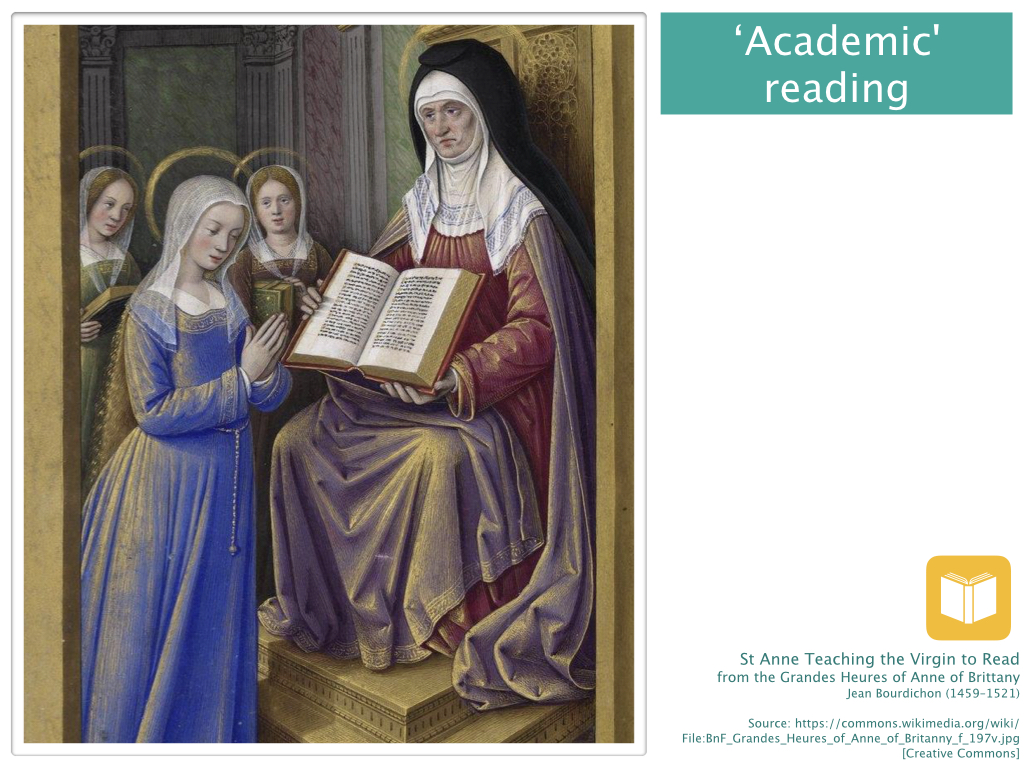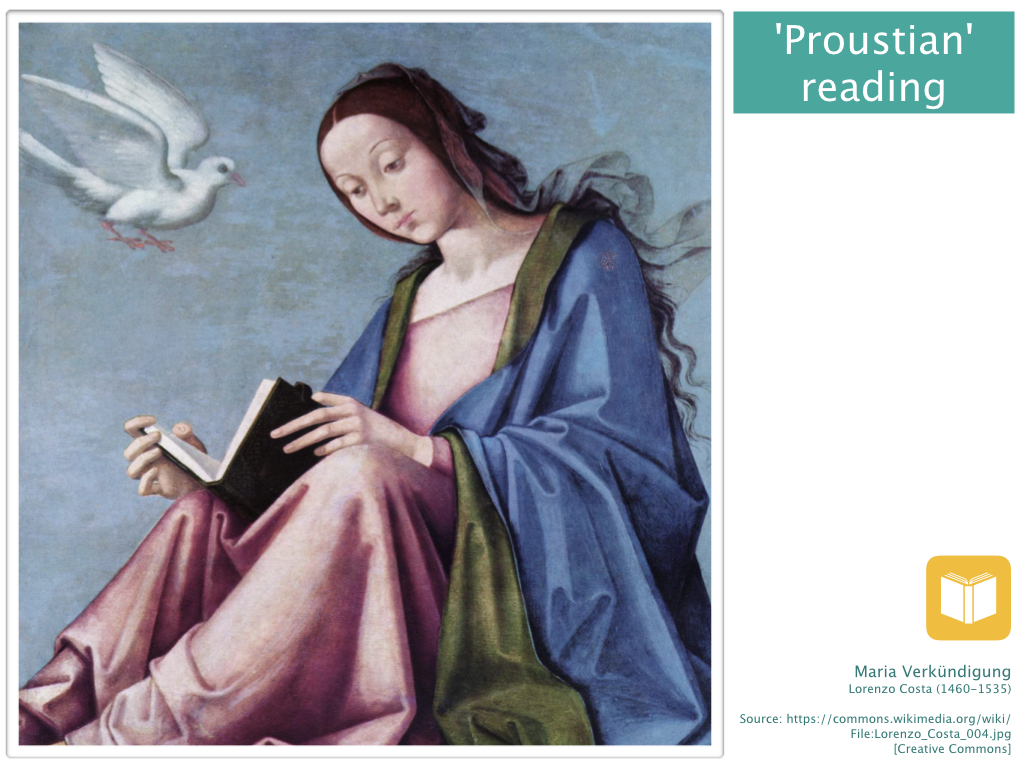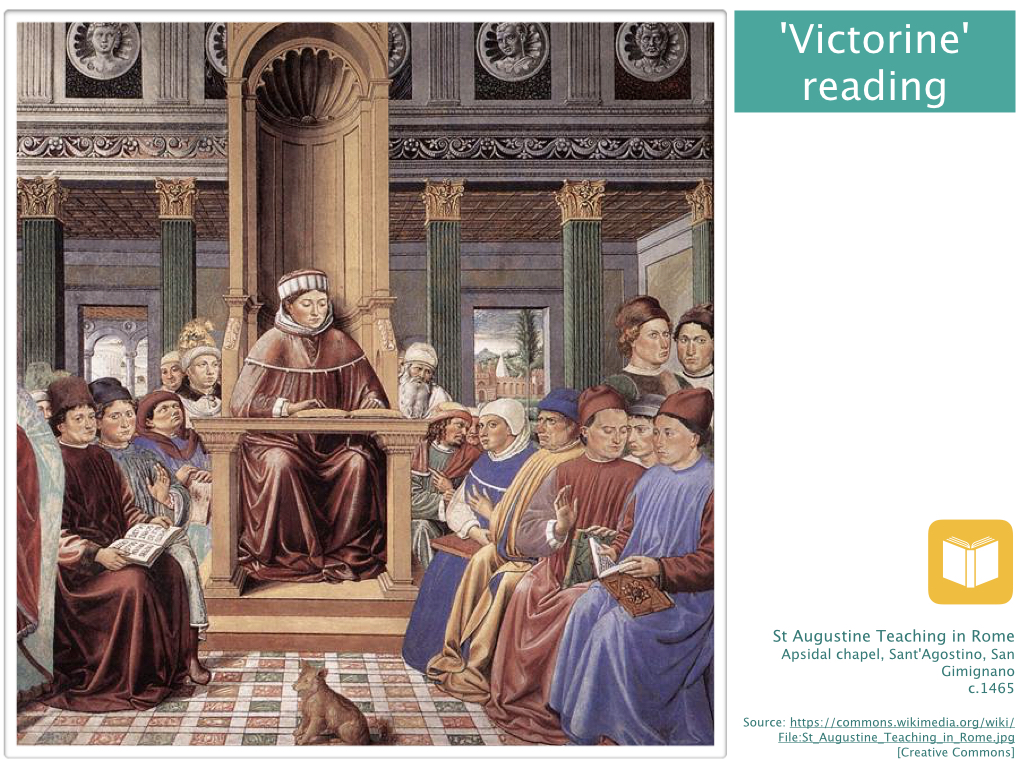Reading Three Ways
| Site: | HubTest |
| Resource: | God and Study Skills |
| Book: | Reading Three Ways |
| Printed by: | Guest user |
| Date: | Wednesday, 10 December 2025, 2:57 PM |
Description
This resource draws from the three kinds of reading Paul Griffiths explores in his book Religious Reading: The Place of Reading in the Practice of Religion (OUP, 1999): academic reading, 'Proustian reading' and 'Victorine reading'. The resource invites you to read a single text (Augustine's Confessions) three times using a different mode of reading each time.
1. Introduction to the exercise
In his book, Religious Reading, Paul J. Griffiths reflects on the place of reading in the Christian imagination. You can read portions of his study by following this link. Griffiths distinguishes between three different ways of understanding and practicing reading:
1) The first kind of reading is ‘academic reading’. This is the reading that focuses on technical mastery. ‘This is reading whose principle tools are the concept deployed in coercive argument and the repeatable experiment’. As this reading is primarily for explanation and analysis, it may well be the primary mode of reading you practice through your training for ministry. It's the kind fo reading you do when you need to excavate a text for resources to help you write your essays and assignments.
2) Proustian reading, by contrast, is reading for pleasure, for reverie, for sensual, aesthetic and very likely sexual enjoyment. The content of the book is secondary to its style and its rhetorical and physical effects upon the reader. Reading is a tool of self-development, not so much training of the mind – as in the first approach – as inculcation of aesthetic sensibilities.
3) The third type of reading, Victorine reading, is reading for moral and religious instruction, formation and value. This is akin to the ancient understanding of lectio divina, although formalized in a complex theory which I need not go into here. Lectio divina, holy reading, was practiced by early Christian monastics, building on Jewish practices of reading scripture, in which communities of monks gave themselves to a slow, ruminative reading and re-reading of the scriptures. This was part of their daily practice, a means of taking the words of scripture from the surface level of the eyes and the mind down into the heart, the seat of the will and of the affections. They understood that the word needs to be chewed slowly before it can be absorbed by the mind and the heart and that this is the slow, patient work of years. The aim was for transformation of mind and heart, the development of the ‘mind of Christ’ in the believer which not only inform thinking but also shape action and disposition, forming a Christlike character in the believer. Reading undertaken in this spirit and conviction is an act of prayer and devotion as much as it is an intellectual discipline. For the early Christians thought and prayer were not separate spheres; the theologian was a person rooted and grounded in scripture and in prayer and right thinking was the fruit of right living, right praying, right desire.
These different approaches to reading can be in real tension and conflict, and this can pose a dilemma for the researcher who is committed to the practice of research as part of their discipleship or spiritual life and yet is required to read comprehensively and exhaustively within the confines of limited time. Academic life, like the rest of society, is increasingly driven by models of consumption and production and it is not surprising that, in this environment, reading (and writing) becomes just another product to consume, to master and to ‘own’, with the emphasis on speed, efficiency of recall and reproduction and a mechanical, mastery model of relationship to the text. This is fundamentally in conflict with models of reading for pleasure (the Proustian) or for contemplation and spiritual formation (the monastic and Victorine).
It sounds like an obvious point to make – that there are different ways of reading the same text – but calling attention to the kinds of ways we read texts can help us to keep track of the theological significance of reading.
The following exercise seeks to apply Griffiths's three fold typology to reading a section from Augustine's Confessions.
2. 'Academic' reading

To recap, 'academic reading' is the reading that focuses on technical mastery. ‘This is reading whose principle tools are the concept deployed in coercive argument and the repeatable experiment’. As this reading is primarily for explanation and analysis, it may well be the primary mode of reading you practice through your training for ministry. It's the kind fo reading you do when you need to excavate a text for resources to help you write your essays and assignments.
With this model in mind, read the first couple of pages of Augustine's Confessions. [We are using the Confessions as an example; feel very welcome to substitute it for another text should you wish.] You may have read these words many times before, or this might be the first time you are reading them. In any case, read them afresh. Read Augustine with 'academic eyes', trying to excavate the text for meaning and information. This isn't an easy text. It might require you to read and read again. In the process of re-reading you may discover something new that gives new insight into what Augustine is trying to say.
If, at any point, you would like to read on, click here to be taken to the e-Book. An alternative translation, which you may find easier, can be found here.
3. 'Proustian' reading

As you read this time, as we move from the academic into the Proustian, you'll need to read the extract again, though the different lens of pleasure. When you re-read the first pages of Confession, shift your attention away from trying to work out what Augustine is saying and whether you agree or disagree with Augustine's words. Think less about how you might excavate the text for meaning and significance. Think not about explanation and analysis but read this text for pleasure. Allow Augustine's words to soak in. Pay less attention to what Augustine is saying and more to how he's communication, to the way he's saying what he's saying. Be attentive to the words themselves; to the form his ideas take. Think about the aesthetics. Imagine the picture Augustine is painting. If you're familiar with Ignaitian patters of praying Scripture, try planting yourself in Augustine's mind, imagining that you are there as Augustine is writing. Think of yourself as the eavesdropper: the one who listens in on Augustine's conversation with God. This is Proustian reading. As Nicola Slee writes,
Proustian reading, by contrast, is reading for pleasure, for reverie, for sensual, aesthetic and very likely sexual enjoyment. The content of the book is secondary to its style and its rhetorical and physical effects upon the reader. Reading is a tool of self-development, not so much training of the mind – as in the first approach – as inculcation of aesthetic sensibilities.
Re-read Augustine's writings in this pleasurable mode. Take time. Don't rush. Read and read again. Be attentive to what difference this shift from the 'Academic' to the 'Proustian' makes to your relation with the text, with Augustine. Are you understanding in a different mode? Are you experiencing the reading differently?
4. 'Victorine' reading

Now for the third way of reading: 'Victorine' reading. This is reading for moral and religious instruction, formation and value. It is akin to the ancient understanding of lectio divina. Lectio divina, holy reading, was practiced by early Christian monastics, building on Jewish practices of reading scripture, in which communities of monks gave themselves to a slow, ruminative reading and re-reading of the scriptures. This was part of their daily practice, a means of taking the words of scripture from the surface level of the eyes and the mind down into the heart, the seat of the will and of the affections. They understood that the word needs to be chewed slowly before it can be absorbed by the mind and the heart and that this is the slow, patient work of years. The aim was for transformation of mind and heart, the development of the ‘mind of Christ’ in the believer which not only inform thinking but also shape action and disposition, forming a Christlike character in the believer. Reading undertaken in this spirit and conviction is an act of prayer and devotion as much as it is an intellectual discipline. For the early Christians thought and prayer were not separate spheres; the theologian was a person rooted and grounded in scripture and in prayer and right thinking was the fruit of right living, right praying, right desire.
As well as re-reading the text, how about listening to the text being read to you. Click here to hear the Confessions. As you listen, think about what difference this make to the reading. There is a memorable passage late in the Confessions where Augustine encounters Ambrose reading without his lips moving. He's struck by the novelty of Ambrose's method. To read, classically, meant to read out loud - it was a public, relational event which involved reader and listener in a participative encounter (as depicted in the scene in the fresco above). We've lost that sense of corporate reading, with most of our reading taking place on our own, individually rather than corporately. Reading is always a formative event. We are not the same after as before reading a text. But reading corporately, out loud in the company of others is especially formative.